Cracker-crust pizza: you’ll need this French dowel rolling pin giveaway WINNERS HAVE BEEN CHOSEN
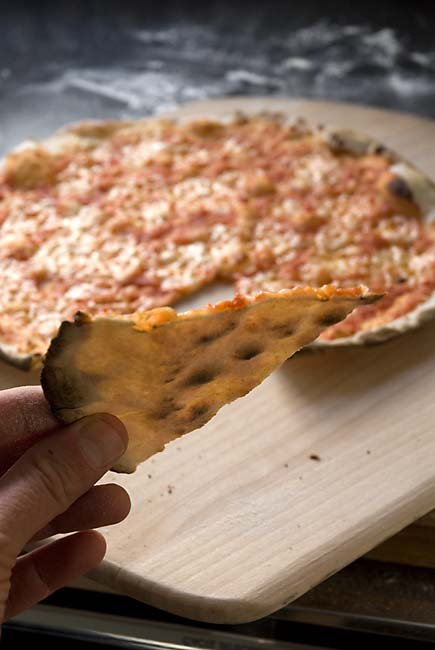
This pizza is so thin and crackly that light shines through it! It’s much easier to achieve perfection with this Tuscan specialty than you might think. You will need a good rolling pin, and the good folks at JK Adams in Vermont have a terrific French dowel rolling pin that we like (especially the thinner 1 1/2″ model), and they’re providing five of them to give away in a drawing here. We prefer these tapered handle-less pins to the handled straight rollered versions–seems that you get better control of thinly-rolled items…
To enter the drawing for the rolling pin: anyone posting a comment to this post will automatically be entered–we’re giving away one of these pins to five lucky winners. Contest closes and winners will be selected seven days after this original post. Usual rules apply (we’ll need your e-mail to notify you, we’ll only ship to a U.S. address, only one entry allowed, and you must respond within 24 hours if you’re a winner). Winners have been chosen and notified…
Everyone knows that cracker-crust pizza needs to be stretched and rolled really, really thin in order to get a crunchy and super-thin result. But before you even start with that, two things to do:
- Pre-heat your oven for 30 minutes or longer, with a glazed or unglazed baking stone in the bottom third of the oven, and use the highest heat your oven allows (for me that’s 550 degrees F). It actually takes my stone about 40 minutes to completely preheat–guaranteeing a great crust.
- Prepare all your toppings before you start stretching the dough: Otherwise the dough will glue itself to the pizza peel while it’s waiting to be topped and you’ll never get it into the oven. Today I used a smooth and thick but plain tomato sauce (less than 1/4-cup), and about 1.5 ounces of fresh mozzarella. Cracker-crust pizzas need very little topping– if you use lots, it won’t crisp and the whole thing may turn to porridge.
In Artisan Pizza and Flatbread in Five Minutes a Day, our cracker-crust pizzas call for a dough-round that’s only 1/16-inch of an inch thick. Maybe there’s someone out there who can do that with their bare hands, but I can’t. I need a rolling pin, and I’ve come to love the handle-less French milled rolling pins, which give you better control in this situation (the JK Adams model in this giveaway is a beauty, milled from super-hard maple). Use a small ball, about 4 ounces (peach-sized) of refrigerated dough from one of our recipes. You need “lean” dough here (those not enriched with eggs and lots of sweetener) from our books: white dough, or the whole-grain are just two examples, see the books for more. Using some whole grain makes it easier to get very thin–plain white dough is the most difficult to stretch because of its gluten-strength. If you use a large ball, you’ll have a very hard time getting it this thin:
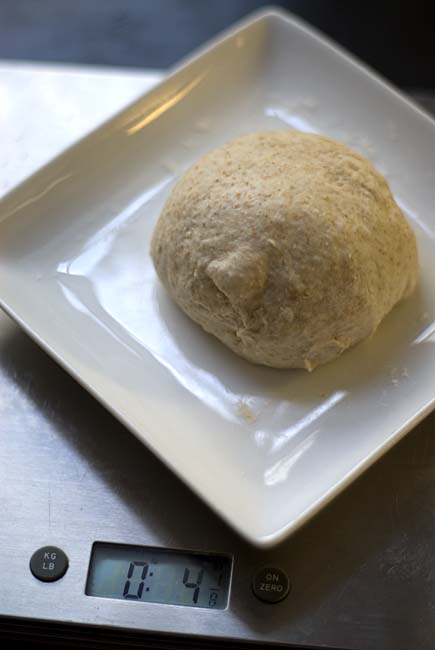
(You don’t really have to weigh it, but it can be nice when you’re learning). Briefly shape it into a ball as in our other posts, and if you have time, let the ball rest under plastic wrap or an overturned bowl at room temperature for up to 60 minutes; that will make it relax and be easier to roll out. So start with the rolling pin and your fingers…

It’s pretty easy to get it to 1/4-inch thick, and then 1/8-inch. But for my ball of dough today, it needed to get to a diameter of about 14 inches in order for the thickness to be down to 1/16-inch…

Use plenty of flour…
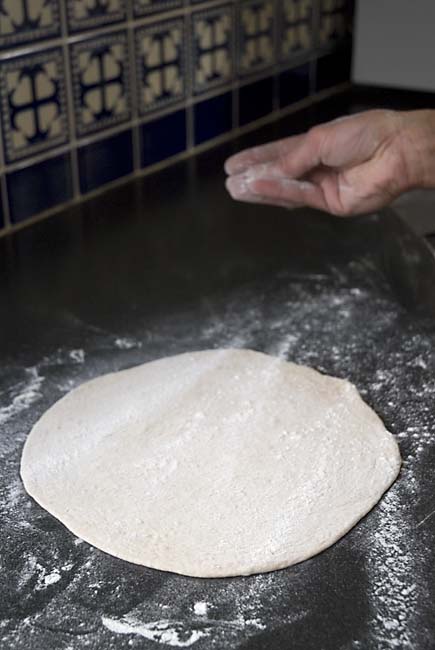
Getting it to 1/16-inch takes a bit of perseverance. Some tricks:
- If it just won’t “relax” and thin out, cover the partially-stretched dough-round with plastic wrap and give the gluten five or ten minutes to relax.
- Use the dough’s own stickiness to force it thin: although you’ll need to dust with lots of flour, allow it to stick to your work surface a little. That pins it down and allows the work surface to oppose its natural tendency to shrink back into its thicker self.
- Use a dough scraper: It’s very difficult to make cracker crust without one, because this dough will try to stick to the work surface, and as I say, you want a little of that. But periodically “un-stick” it, like so:
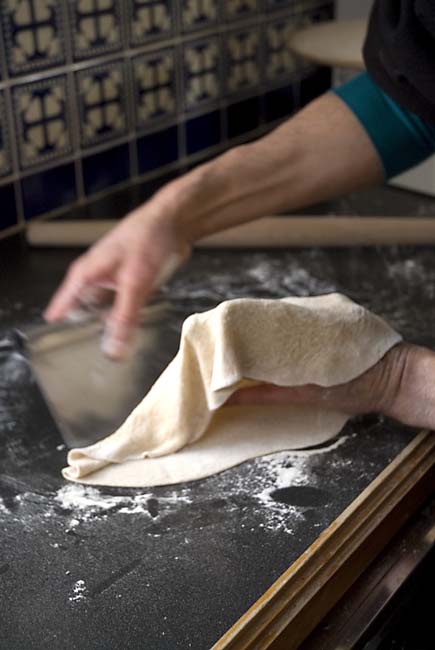
As you gather it up in your other hand, you can see that the top surface is going to need lots of dusting flour. Don’t be stingy with it; most of it will fall off as you work with it. You know you’re getting close when the dough is looking paper-thin, and draping your hands like a glove:
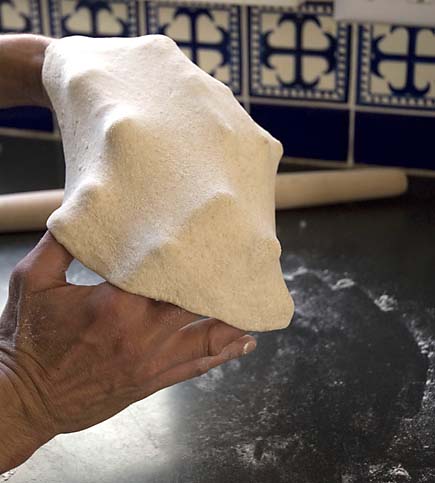
When you get to 1/16-inch thickness, place the dough-round onto a pizza peel dusted with flour. Periodically shake the peel to be sure that you’re not sticking. Start with the sauce; you can use a spoon, but a pastry brush is quite handy for the thin coating of sauce that’s called for here:

… OK, maybe a little more than that, but don’t overdo it:

In our pizza book, our cracker-crust pizzas don’t call for the big cheese chunks that work so nicely on Neapolitan-thickness pizza– go for grated cheese if you’re using commercial mozzarella, or small pieces of fresh mozzarella as in these pictures (you really can’t grate the fresh stuff, it just disintegrates). And not so much– 1.5 ounces is enough here:

… so you’re spacing the cheese a little. Now slide it onto the pre-heated stone (more on that technique in the book). Hopefully the 30-minutes preheat was enough, but if you’re not getting the crispiness you like, next time preheat for up to an hour:

In my oven, which runs hot (and I’m never getting that fixed), this was ready in 5 minutes. If your oven runs cooler, you’ll need more time, but check early– this is thin stuff and you don’t want it burning. Check your oven with a thermometer or it can be challenging to get the crispiness you want. A little scorching is OK– see the blackened bits on the underside and at the edge, and yes, the light should shine through it:
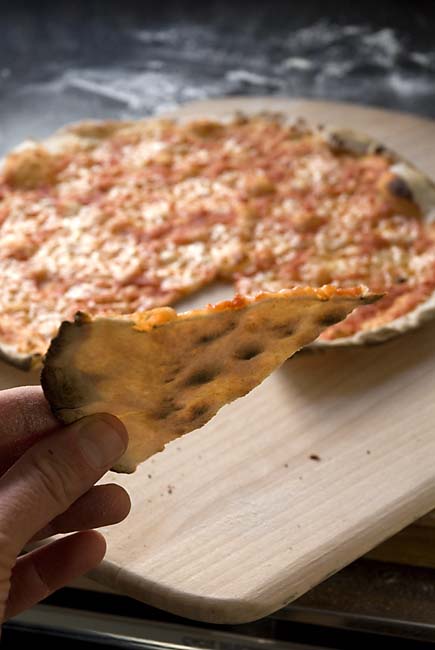
Give my regards to Siena!
Lovely! I’d love to win the rolling pin.
I picked up your book about a month ago and have made three recipes so far! Can I say all have been so good. I took the cinnamon rolls to a family dinner for desert and no one knew they were gluten free!!! My next bread this weekend is the buttermilk – since I have some buttermilk laying around – cannot wait to make another bread!!
I would like that rolling pin! The crust looks delicious!
What is your secret for getting it rolled out round? I’m never able to do it!
Thanks for the tip to use part whole grain to make it easier to achieve thin crust. I’ve come close but will try again with all the good tips in this post.
I want one!!!!! My rolling pin never does the job the way I want it done.
Yes. I would love the rolling pin.And that pizza looks so good!
I love thin crust pizza and this looks perfect. Will try it as soon as I get home. 🙂
We have homemade pizza frequently and this rolling pin will be great!
This looks delicious. I’ll make it this weekwnd:(. Please enter me in the drawing for the rolling pin:) Thank you!
Love your books, love your recipes. You have made me into a bread and pizza Baker. Thanks.
Can’t wait to try this!
Awesome giveaway! In the battle of my french rolling pin vs. my husband’s american-style handles and spin action pin, mine lost. I do regret it a little now, so would love to get a new one.
I have a couple of questions about baking, too:
1. Have you guys tried using higher heat? I like a darker crust, so am tempted to do so.
2. Have you noticed any improvement in flavor using very little yeast and a longer initial rise? My crust has some slightly weird flavors that I’m thinking are due to more yeast than I’m used to baking with.
3. How would it affect things to increase the hydration of the dough a little? I like a very moist crumb, and if I’m gonna bake the heck out of the crust, probably would be a good idea to have a little more water in there to begin with.
4. Can I bake longer/at higher temperature to get rid of any alcohol flavor in the crumb? I think I’m homozygous for not being able to process alcohol properly, and it tastes like turpentine to me. I can detect very small amounts, and I don’t like it much.
Hi Jen,
1. I tend to bake pizza at the highest temperature my oven will go. You just have to keep a close eye on the crust, especially if you are making a cracker crust. Make sure your pizza stone is properly preheated, this will take 30 to 60 minutes depending on the thickness.
2. Here is a post about reducing the yeast: https://artisanbreadinfive.com/2007/12/19/low-yeast-version-of-our-master-recipe
3. Our dough is typically wetter than most doughs, so I wonder if you’ll enjoy working with it if it’s much wetter? What kind of flour are you using?
4. The lower amount of yeast will take care of the alcohol flavor. Making sure your bucket is vented will also help prevent this. Baking it will help, but not get rid of the flavor if you tend to be sensitive to it. I perceive the same flavor in the high yeast dough and Jeff doesn’t seem to notice it at all.
Thanks! Zoë
Looks great! I’ll be trying it soon.
YES! More great pizza ideas. Keep ’em coming and thanks.
Looking forward to baking this pizza.
G
I’m making pizza tonight with garlic-herb dough (I just added some oregano and some fresh garlic to the NewABin5 master recipe). I like thicker crust, but it would be fun to try the thin crust. And I’d love one of these rolling pins!
I love making home-made pizza. Would really like the rolling pin.
This looks great. I will make a copy of it for myself.
Phil
that looks super yum!
This pizza looks delicious! I have had a French dowel rolling pin on my wish list for awhile now. I would love to win one!
Love the thin crust! Have you try veggies or meat on it. If so, how many ounces?
Hi Cindy,
You want to keep the veggies dry on this crust, so anything that will release water when cooked, you want to precook before putting it on your dough. Don’t use more than 1/2 a cup or it will make the dough soggy.
Thanks, Zoë
Yes! This is my favorite type of pizza crust. I’ve never found a recipe that is close to it. I hope this is the one.
We like the really thin crust the best, this rolling pin would sure help.
Hi Jeff, I seen you make this pizza at class in the Linden Hills Coop. It was delicious!!! I would love to win the rolling pin. I’ve been making the basic recipe bread now for over a year and since your class have expanded my baking and really enjoying it. Sharing with others!!!
looks fantastic
cant wait to try it in my pizza oven
the oven peaks at 800-900 degrees
Pizza is probably the bread we make most often, and I’ve managed to get it pretty thin with one of those marble rolling pins, but it is pretty heavy.
I’m surprised that the whole grain dough actually works better than the white. I’ve never tried it because I thought it was the opposite!
As always, I cannot wait to try this recipe! Thanks for the post!
Yes please, I’d love a rolling pin!
Does this work with GF crusts? I would love thin crisp pizza that is GF.
Since I have pizza on my menu for the weekend lunch, I look forward to trying this. Would love to win the rolling pin.
I love a crisp cracker crust and really appreciate the images and instruction you’ve provided. Looking forward to trying the whole grain version.
I have always wanted to try one of these rolling pins, but didn’t think I wanted to purchase a second rolling pin for the house in case I didn’t like it. This would be great.
That looks delicious!!
That looks delicious!I love thin crust pizza.
I’m almost as nuts about rolling pins as I am about bread. Thanks for the tutorial!
Yum! Can’t wait to try this making this pizza crust…thanks for the great blog!
I would love this pin!
Love your books! I only make my own bread now. I have given your books as gifts to many people too. Looking forward to trying this crust. Yum!
pizza looks delicious. Love that rolling pin
Anything you make is fabulous! Need the rolling pin so I can make this one too!,, please, please, please…
Oh, yum! I’ve already had my supper, but I want a piece of thin pizza SO badly right now!
I love your cookbook so much, I bought the newest one for myself and gave my older one to my daughter. I love thin crust pizza and would love to have the rolling pin. Thanks for the chance to win.
I love all your books. Use them all the time.
Looking forward to trying it this weekend. How is it on the grill with a baking stone?
Would love the rolling pin.
i use your book for making bread 2-3 times a week. We love it!!
Momma Mia…I needa thata rollin pina!!!
Inamorata <3
I’ve been wanting one of these for a while now. I hope I get one! Thanks!
love your methods, and i would love to get a rolling pin.
Wow, that looks like a great pizza. I’ve never tried to get one that thin! I’d love to win the rolling pin and try. I hope it would work on a preheated cast iron griddle; that’s what I use instead of a stone.